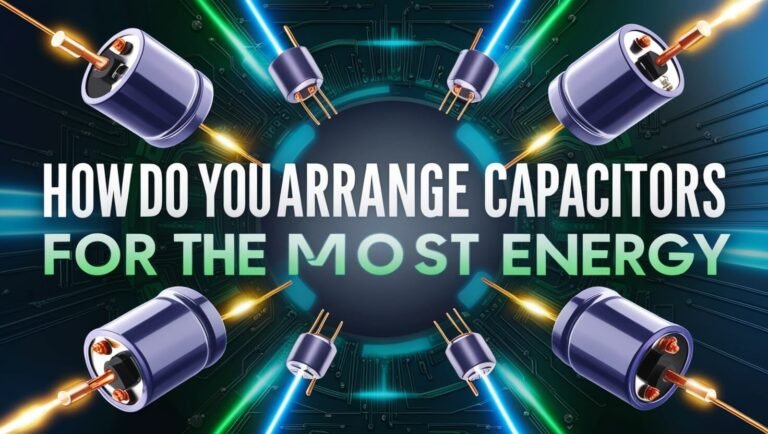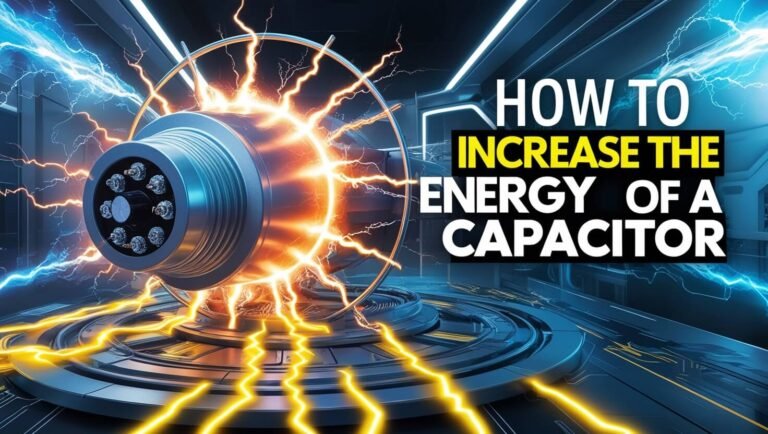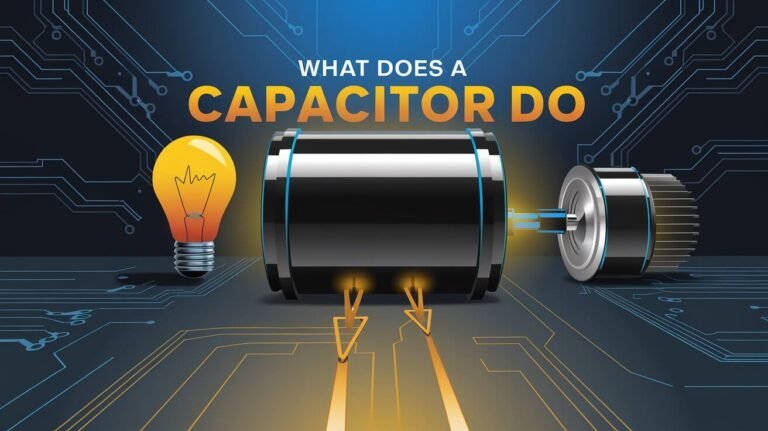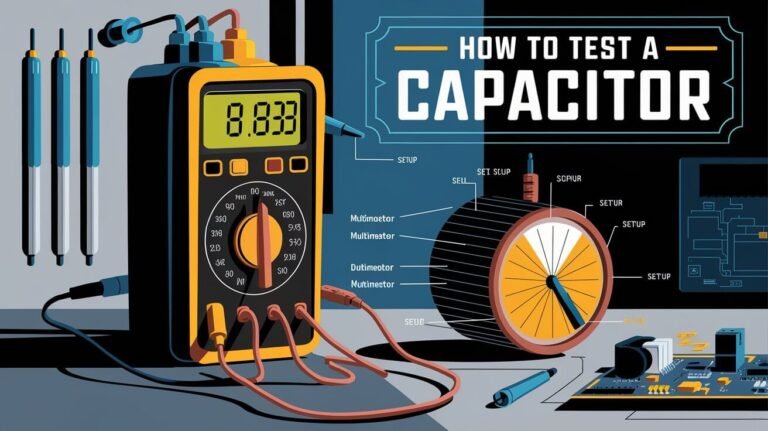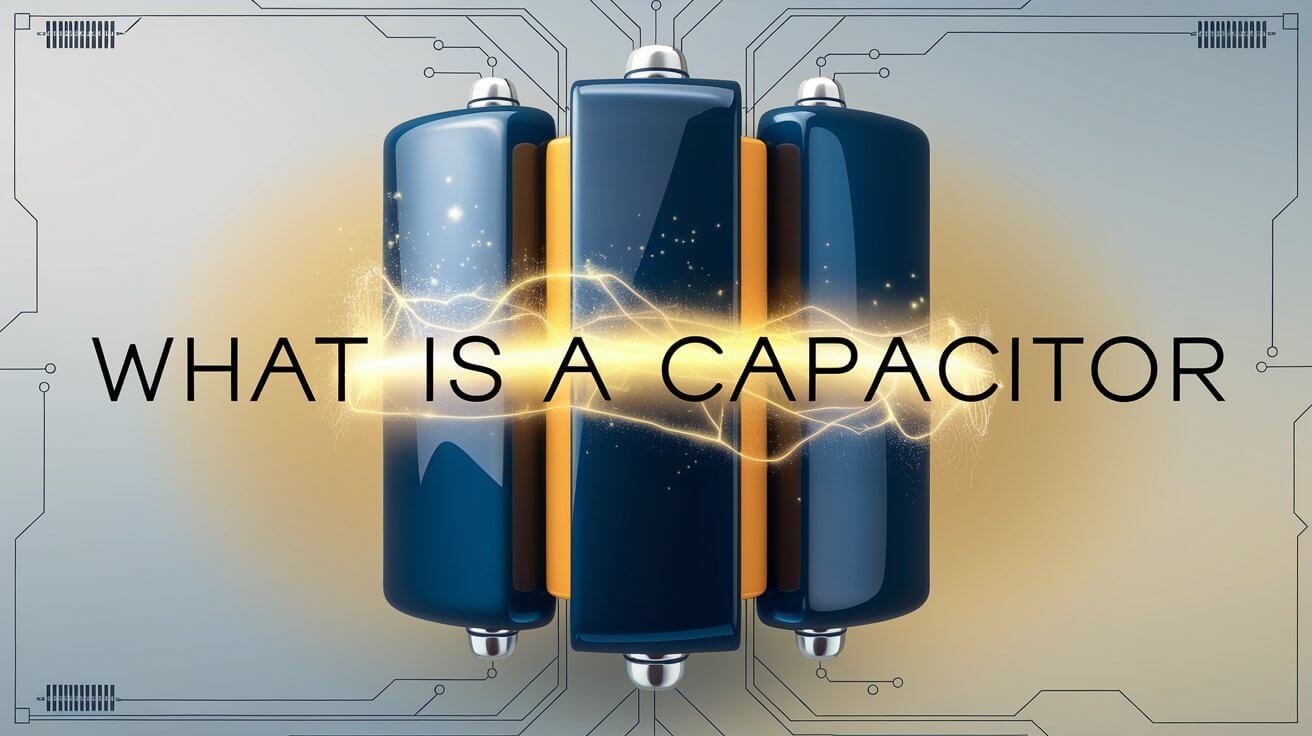
A capacitor is a key electrical part that stores energy by holding electric charges. It has two terminals and was invented in 1745. It’s vital in many electronic devices, helping with energy storage and charge buildup.
Capacitors can store energy by holding electric charges on two surfaces. These surfaces are close together but not touching. This makes them important in many devices, from simple circuits to complex systems. They are used for storing energy and are key in modern electronics, like power supplies and filters.
Basic Functions of a Capacitor
Capacitors are key in electronic circuits. They have two conductors and a non-conductive area called a dielectric. This setup lets them store energy in an electric field. They can charge and discharge, making them useful in many areas, like camera flashes.
The conductors and dielectric are the heart of a capacitor. The conductors, usually metal, hold electric charge. The dielectric, made of materials like gases or ceramics, keeps the conductors apart. This design lets capacitors store energy, making them essential in many devices.
Energy Storage Mechanism
Capacitors store energy through an electric field. When a voltage is applied, electric charge builds up. The dielectric material increases the capacitor’s ability to store energy. This stored energy can be released when needed, making capacitors valuable in many applications.
Charge and Discharge Cycles
Capacitors can go through many charge and discharge cycles. During charging, a voltage builds up electric charge on the conductors. When discharged, the stored energy is released. This cycle can happen many times, making capacitors reliable in electronic circuits.
Core Components
The conductors and dielectric are key to a capacitor’s function. The conductors store electric charge, and the dielectric increases capacitance. Together, they enable capacitors to store energy in an electric field. Understanding these components shows why capacitors are so important in electronics.
| Capacitor Type | Dielectric Material | Advantages |
|---|---|---|
| Ceramic Capacitor | Ceramic | Small size, high temperature stability |
| Film Capacitor | Plastic film | High voltage tolerance, long lifespan |
| Electrolytic Capacitor | Electrolytic solution | High capacitance, low cost |
Types of Capacitors and Their Properties
Ceramic, electrolytic, and film capacitors are key types used in electronics. Each has special properties for different uses. Ceramic capacitors are great for high frequencies, found in things like remote controls and audio gear.
Electrolytic capacitors need a lot of capacitance and are polarized. They’re used in big power supplies and audio devices. Film capacitors are cheap and last forever, making them perfect for filtering noise and coupling signals.
| Capacitor Type | Properties | Applications |
|---|---|---|
| Ceramic Capacitors | High frequency stability, high capacitance values | Remote controls, audio equipment |
| Electrolytic Capacitors | Large capacitance, polarized | Power supplies, audio equipment |
| Film Capacitors | Inexpensive, unlimited shelf life | Noise filtering, coupling, decoupling |
Choosing the right capacitor depends on the project’s needs. Knowing the properties and uses of each type helps designers pick the best capacitors for their work.
Working Principles of Capacitors in Circuits
Capacitors are key in keeping circuits stable. They control voltage and current flow. They block DC but let AC signals through, making them vital in many devices.
Capacitors keep unwanted signals out and prevent voltage changes. This is critical for devices needing a steady voltage. The capacitor’s resistance to AC current, or capacitive reactance, is important for circuit performance.
Voltage Regulation
Capacitors regulate voltage by storing and releasing energy. This keeps the voltage stable, protecting electronic parts. The capacitor’s ability to store energy is measured in farads.
Current Flow Control
Capacitors manage current flow by blocking DC and letting AC pass. This is due to their capacitive reactance, which changes with frequency and capacitance. The capacitor’s ability to pass current depends on these factors.
Signal Filtering
Capacitors filter out unwanted signals, improving circuit performance. The capacitor’s impedance, influenced by its reactance, is key in filtering. Choosing the right capacitor ensures only desired signals pass through.
| Capacitor Type | Capacitance Value | Impedance |
|---|---|---|
| Ceramic Capacitor | 1-100 nF | 10-100 ohms |
| Electrolytic Capacitor | 1-100 uF | 1-10 ohms |
| Film Capacitor | 1-100 nF | 10-100 ohms |
Common Applications Across Industries
Capacitors are key in many fields, from gadgets to big machines. They store energy and clean up signals. This makes them vital in lots of devices. For example, in power supplies, they smooth out the output of rectifiers.
In gadgets like phones and TVs, capacitors are everywhere. They’re also in big machines like motors and power systems. Plus, they’re used in things like camera flashes and backup power systems.
Consumer Electronics
Capacitors are in many gadgets, like audio gear and computers. They filter signals, store energy, and control power flow. For instance, big capacitors power car audio systems.
Industrial Equipment
In big machines, capacitors power motors and generators. They also fix power issues caused by devices like electric motors. In UPS, they help keep power going without needing to be replaced.
Power Distribution Systems
Capacitors keep power steady in power systems. They stop blackouts and handle changes in power sources. They also make sending power over long distances more efficient.
| Application | Use of Capacitors |
|---|---|
| Power Supplies | Smoothing output of rectifiers |
| Timing Circuits | Regulating flow of energy |
| Energy Storage | Storing energy for later use |
Real Circuit Examples With Capacitors
Circuit design and electronic schematics are key to understanding capacitors. In real circuits, capacitors store energy, filter signals, and control voltage. For example, in power supplies, they smooth out voltage and provide a stable output.
In timing circuits, capacitors work with resistors to set timing. The time constant, τ = RC, shows how fast a capacitor charges or discharges. This is vital in flash photography, where a quick capacitor discharge is needed for a brief, intense flash.
Some common uses of capacitors include:
- Filtering circuits: They filter out unwanted frequencies and let desired ones pass through.
- Voltage regulation: They help regulate voltage and provide a stable output in power supplies.
- Signal processing: They process signals and remove noise in audio and video circuits.
In electronic schematics, capacitors are shown by a symbol that shows their polarity and value. Capacitor values are measured in farads (F), ranging from pico-farads (10^-12 F) to micro-farads (10^-6 F). Knowing capacitor values and polarity is key to designing efficient and safe circuits.
| Capacitor Type | Value | Application |
|---|---|---|
| Ceramic Capacitor | 10^-12 F to 10^-6 F | Filtering and coupling circuits |
| Electrolytic Capacitor | 10^-6 F to 10^-3 F | Power supplies and voltage regulation |
| Film Capacitor | 10^-12 F to 10^-6 F | Signal processing and audio circuits |
Understanding circuit design and electronic schematics helps engineers and hobbyists create innovative projects. Capacitors are essential in designing efficient and safe electronic devices, whether for power supplies, timing circuits, or signal processing.
Capacitor Ratings and Specifications
Choosing the right capacitor is key. Capacitance is measured in farads (F), often in microfarads (µF) or picofarads (pF). The voltage tolerance is also important. It shows the maximum voltage a capacitor can handle.
Capacitors work with different DC voltages like 10V, 16V, and 100V. Tolerances range from 5% to 10%. Some, like plastic ones, can have a tolerance as low as ±1%.
Voltage Ratings
Voltage ratings are very important. Capacitors work within certain temperature ranges. For plastic capacitors, the working temperature is no more than +70oC.
The temperature coefficient shows how a capacitor’s value changes with temperature. This is important for precise circuits. Capacitors can have coefficients from P1000 to N5000, making them useful for many applications.
Safety Measures and Handling Guidelines
Working with capacitors requires careful safety steps to avoid electrical shocks. Large capacitors can hold a lot of charge, even when not connected. It’s important to follow discharge procedures to stay safe.
To keep things electrical safe, wear insulated gloves and safety goggles. Also, make sure capacitors are clearly marked with their voltage and safety warnings. This helps avoid overvoltage risks.
Important safety steps include: * Always turn off power and discharge capacitors before starting work * Use insulated pliers for smaller capacitors * Wear safety glasses to protect against electrical arcs * Follow high voltage precautions for high-voltage capacitors * Connect a wire across the terminals of a discharged capacitor to prevent accidental discharge
Taking these precautions, you can reduce risks when working with capacitors. This ensures a safe working space.
Troubleshooting Capacitor Issues
Capacitors can fail for many reasons, like age, voltage stress, and heat. It’s important to test and replace them to keep electronic devices working. Signs of a bad capacitor include bulging, cracks, and fluids leaking from the casing.
Common Failure Modes
A failing AC capacitor can make an air conditioner short-circuit or overheat. This can cause it to break down. Common causes include overheated systems, poor ventilation, power surges, lightning strikes, and extreme temperatures.
Testing Methods
There are several ways to test capacitors, like using ESR meters, multimeters, or capacitance meters. Voltage testing checks if a capacitor works right, making sure it holds the expected voltage. Using electronic diagnostics is key to finding capacitor problems.
Replacement Procedures
When replacing capacitors, use one that’s the same or higher value than the old one. Bad capacitors often show bulging tops, a common sign in power supplies. An HVAC technician can replace an AC capacitor in under an hour.
Innovation and Modern Capacitor Technology
Recent breakthroughs in capacitor tech have brought us supercapacitors with high energy density. These are perfect for short power needs. Nanotechnology has also improved capacitor performance, making devices smaller and more efficient.
Some major innovations in capacitor tech include:
- Supercapacitors that mix capacitor and battery features for high energy and quick charging
- High-k dielectrics that boost capacitance per volume, allowing for smaller devices without losing performance
- Research on organic and polymer dielectrics for flexible electronics and displays
These advancements are opening up new uses, like in electric cars, green energy systems, and advanced medical tools. As scientists keep exploring new materials and tech, we’ll see even more creative capacitor designs. These will help us store and release energy in new ways.
| Capacitor Type | Energy Density | Charge/Discharge Cycles |
|---|---|---|
| Supercapacitors | High | Long |
| Nanotechnology-based capacitors | High | Fast |
| Traditional capacitors | Low | Short |
Final Verdict
Capacitors are the unsung heroes of modern electronics. They quietly power our sophisticated devices and systems. From gadgets to industrial equipment, they keep evolving, driving innovation.
As technology advances, capacitors adapt to meet new demands. They store energy, regulate voltages, and filter signals. This makes them essential in many applications, ensuring our devices work reliably.
The future of capacitor technology looks bright. New designs, like supercapacitors, could change how we store and use energy. They promise fast charge and discharge, which could transform powering our electronic devices and industrial equipment. The ongoing innovation in capacitor technology will shape our connected, tech-driven world.
Frequent Questions
What is a capacitor?
A capacitor is a key part of electronics that holds electrical energy. It helps in many ways, like controlling voltage and filtering signals. This makes it vital in today’s gadgets and devices.
How do capacitors work?
Capacitors store energy by creating an electric field. This field is between two conductors and a special material. They can hold and release energy, which is important for electronic circuits.
What are the different types of capacitors?
There are many types of capacitors, each with its own use. You have ceramic, electrolytic, and film capacitors. They are used in everything from small gadgets to big industrial systems.
How do capacitors function within electrical circuits?
In circuits, capacitors help with voltage, current, and filtering signals. They work differently with AC and DC. This affects how stable and functional the circuit is.
Where are capacitors used in different industries?
Capacitors are used in many fields, from electronics to big industrial systems. They help make many devices work better. This includes everything from remote controls to huge power systems.
Can you provide examples of capacitors in real circuits?
Capacitors are key in many circuit designs. By looking at examples, we see how they improve electronic systems. This makes them more functional and efficient.
What are the key ratings and specifications of capacitors?
Capacitors have important ratings like capacitance and voltage. Knowing these helps pick the right capacitor. It ensures your electronics work well and last long.
What safety measures should be taken when working with capacitors?
Capacitors can be dangerous because they store energy. Always follow safety rules when handling them. This keeps you and your devices safe.
How can capacitor issues be diagnosed and addressed?
Capacitors can fail in different ways. Knowing how to spot and fix these problems is key. Testing and replacing capacitors can solve many issues.
What are the latest innovations in capacitor technology?
New capacitor technologies, like supercapacitors, are changing things. They use nanotechnology to store more energy. These advancements are exciting for many industries and the future of electronics.

